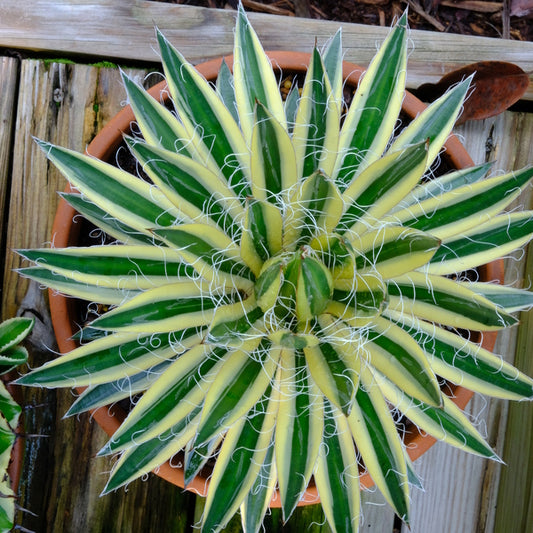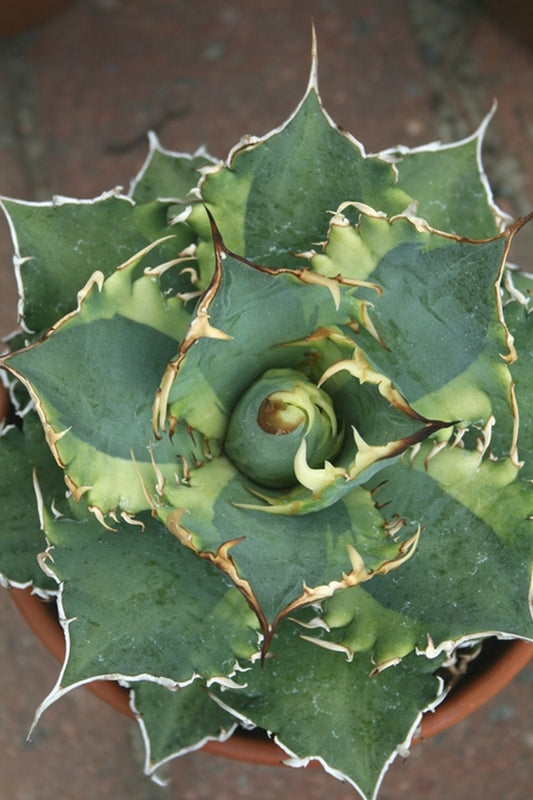By definition a variegated plant is one whose tissues vary in color. In the garden, variegated plants can lighten up a normally dark landscape. In landscape design, variegated plants are often used as the center of attention or as a focal point in the landscape.
-
Agave potatorum 'Lonkie'
Item #: 14785
Zones: Tropical
Dormancy: Evergreen
Height: 12" tall
Culture: Sun to Part Sun
Origin: Mexico
Pot Size: 3.5" pot (24 fl. oz/0.7 L)
Regular price $65.00Regular priceUnit price per -
Agave potatorum 'South Pole'
Item #: 14293
Zones: Tropical
Dormancy: Evergreen
Height: 6" tall
Culture: Sun to Part Sun
Origin: Mexico
Pot Size: 3.5" pot (24 fl. oz/0.7 L)
Regular price $65.00Regular priceUnit price per -
Agave x romanii 'Gipsy Queen'
Item #: 14784
Zones: 9b to 11
Dormancy: Evergreen
Height: 18" tall
Culture: Sun
Origin: Hybrid
Pot Size: 3.5" pot (24 fl. oz/0.7 L)
Regular price $40.00Regular priceUnit price per$50.00Sale price $40.00Sale -
Agave x romanii 'Shadow Dancer'
Item #: 3742
Zones: 8b to 10b, guessing
Dormancy: Evergreen
Height: 12" tall
Culture: Sun to Part Sun
Origin: Hybrid
Pot Size: 3.5" pot (24 fl. oz/0.7 L)
Regular price $65.00Regular priceUnit price per -
Agave schidigera 'Bright Lights'
Item #: 10279
Zones: 9a to 10b
Dormancy: Evergreen
Height: 15" tall
Culture: Sun
Origin: Mexico
Pot Size: 3.5" pot (24 fl. oz/0.7 L)
Regular price $40.00Regular priceUnit price per$50.00Sale price $40.00Sale -
Agave schidigera 'Royal Flush' PP 31,138
Item #: 14272
Zones: 9a to 10b
Dormancy: Evergreen
Height: 12" tall
Culture: Sun
Origin: Mexico
Pot Size: 3.5" pot (24 fl. oz/0.7 L)
Regular price $31.20Regular priceUnit price per$39.00Sale price $31.20Sale -
Agave simplex 'Snow Devil'
Item #: 10015
Zones: 9b to 11
Dormancy: Evergreen
Height: 20" tall
Culture: Sun to Part Sun
Origin: United States
Pot Size: 3.5" pot (24 fl. oz/0.7 L)
Regular price $52.00Regular priceUnit price per$65.00Sale price $52.00Sale -
Agave titanota 'Banana Peel'
Item #: 9348
Zones: 9a to 10b
Dormancy: Evergreen
Height: 12" tall
Culture: Sun to Part Sun
Origin: Mexico
Pot Size: 3.5" pot (24 fl. oz/0.7 L)
Regular price $30.40Regular priceUnit price per$38.00Sale price $30.40Sale -
Agave titanota 'Genryu Kifukurin'
Item #: 8983
Zones: 9a to 10b, at least
Dormancy: Evergreen
Height: 12" tall
Culture: Sun to Part Sun
Origin: Mexico
Pot Size: 3.5" pot (24 fl. oz/0.7 L)
Regular price $36.00Regular priceUnit price per$45.00Sale price $36.00Sale -
Agave titanota 'Snaggle Tooth'
Item #: 13801
Zones: 9a to 11
Dormancy: Evergreen
Height: 15" tall
Culture: Sun
Origin: Mexico
Pot Size: 3.5" pot (24 fl. oz/0.7 L)
Regular price $100.00Regular priceUnit price per -
Agave titanota 'Sunburst'
Item #: 9517
Zones: 9a to 11
Dormancy: Evergreen
Height: 18" tall
Culture: Sun
Origin: Mexico
Pot Size: 3.5" pot (24 fl. oz/0.7 L)
Regular price $31.20Regular priceUnit price per$39.00Sale price $31.20Sale -
Agave titanota 'X-Rays'
Item #: 11077
Zones: 9a to 10b, at least
Dormancy: Evergreen
Height: 12" tall
Culture: Sun to Part Sun
Origin: Mexico
Pot Size: 3.5" pot (24 fl. oz/0.7 L)
Regular price $44.00Regular priceUnit price per$55.00Sale price $44.00Sale -
Agave victoriae-reginae 'Kizan'
Item #: 8834
Zones: 8b to 11, guessing
Dormancy: Evergreen
Height: 12" tall
Culture: Sun to Part Sun
Origin: Mexico
Pot Size: 3.5" pot (24 fl. oz/0.7 L)
Regular price $42.00Regular priceUnit price per -
Agave victoriae-reginae 'Sun King'
Item #: 13522
Zones: 8b to 11, guessing
Dormancy: Evergreen
Height: 12" tall
Culture: Sun to Part Sun
Origin: Mexico
Pot Size: 3.5" pot (24 fl. oz/0.7 L)
Regular price $40.00Regular priceUnit price per$50.00Sale price $40.00Sale -
Agave victoriae-reginae 'Tora Fu'
Item #: 8599
Zones: 8a to 10b, guessing
Dormancy: Evergreen
Height: 10" tall
Culture: Sun to Part Sun
Origin: Mexico
Pot Size: 3.5" pot (24 fl. oz/0.7 L)
Regular price $31.20Regular priceUnit price per$39.00Sale price $31.20Sale -
Agave vilmoriniana 'Stained Glass'
Item #: 11904
Zones: 9a to 11
Dormancy: Evergreen
Height: 48" tall
Culture: Sun to Part Sun
Origin: Mexico
Pot Size: 3.5" pot (24 fl. oz/0.7 L)
Regular price $30.40Regular priceUnit price per$38.00Sale price $30.40Sale -
Agave xylonacantha 'Frostbite'
Item #: 8723
Zones: 9a to 10b, guessing
Dormancy: Evergreen
Height: 18" tall
Culture: Sun
Origin: Mexico
Pot Size: 3.5" pot (24 fl. oz/0.7 L)
Regular price $32.00Regular priceUnit price per -
Ajuga tenorei 'Princess Nadia' PP 31,028
Item #: 15031
Zones: 4a to 9b
Dormancy: Evergreen
Height: 3" tall
Culture: Part Sun to Light Shade
Origin: Italy
Pot Size: 3.5" pot (24 fl. oz/0.7 L)
Regular price $15.20Regular priceUnit price per$19.00Sale price $15.20Sold out -
Alocasia cucullata 'Yellow Tail'
Item #: 7588
Zones: 7b to 10b
Dormancy: Winter
Height: 36" tall
Culture: Sun to Part Sun
Origin: Burma/Myanmar, India
Pot Size: 3.5" pot (24 fl. oz/0.7 L)
Regular price $29.00Regular priceUnit price per -
Alocasia odora 'Tropical Mist'
Item #: 11394
Zones: 8b to 10b
Dormancy: Winter
Height: 36" tall
Culture: Sun to Part Sun
Origin: China, India
Pot Size: 3.5" pot (24 fl. oz/0.7 L)
Regular price $80.00Regular priceUnit price per$100.00Sale price $80.00Sale -
Alpinia pumila
Item #: 8542
Zones: 7b to 10b
Dormancy: Winter
Height: 6" tall
Culture: Light Shade to Shade
Origin: China
Pot Size: 3.5" pot (24 fl. oz/0.7 L)
Regular price $26.00Regular priceUnit price per -
Alstroemeria 'Phoenix'
Item #: 17035
Zones: 7b to 9b, at least
Dormancy: Winter
Height: 32" tall
Culture: Part Sun to Light Shade
Origin: Hybrid
Pot Size: 3.5" pot (24 fl. oz/0.7 L)
Regular price $38.00Regular priceUnit price per -
Alstroemeria 'Princess Fabiana' PP 17,991
Item #: 9555
Zones: 6a to 8b, at least
Dormancy: Winter
Height: 10" tall
Culture: Sun to Part Sun
Origin: Hybrid
Pot Size: 3.5" pot (24 fl. oz/0.7 L)
Regular price $29.00Regular priceUnit price per -
Amorphophallus konjac 'Shattered Glass'
Item #: 16691
Zones: 6a to 10b
Dormancy: Winter, Spring
Height: 60" tall
Culture: Part Sun to Light Shade
Origin: China
Pot Size: Bare Root / 3.5" pot (24 fl. oz/0.7 L)
Regular price $80.00Regular priceUnit price per
More Information About Variegated Foliage Plants
What is the definition of a variegated plant?
Variegation is defined as the phenomenon where parts of a plant leaf, stem or fruit have zones whose color varies from the surrounding tissue or from normal tissue. Variegation can be part of a plant's adaptation to its environment where the color patterns attract pollinators or seed dispersers to the plant. For example, the purple chevrons seen on Curcuma or the purple spots on the stems of Amorphophallus. Or a plant may be variegated due to a genetic flaw in a particular tissue that prevents the production of the normal green pigment chlorophyll...like Hostas and Agaves with yellow leaf edges. Or variegation can be caused by viruses or other disease organisms.
(Article excerpt from Leaves that Light Up the Garden):
Variegated plants are most appreciated by serious plant collectors, probably because of their uniqueness. If everyone has a green form of plant , then the plant collector naturally wants to have the variegated form, often simply to be different.
Some gardeners like the patterning in the leaf...usually the arts and croissant crowd. Designers often like the ability of variegated plants to lighten up a normally dark landscape. In a landscape design, variegated plants are often used as the center of attention or as a focal point in the landscape.
Inquiring minds want to know what qualifies as a variegation. Variegation in plants is defined as the normal green portion of the plant leaf being replaced by white, cream, yellow, or occasionally other colors, which may be in the form of blotches or stripes. The variegations can occur on the edge of the leaves (marginate variegation), or in the center of the leaf (medio variegation.) Variegated plants which have neat regular leaf margins of white or gold and tend to be the most accepted by gardeners.
Less accepted by gardeners are variegated plants whose foliage is streaked with uneven patterning. These plants are often highly prized by plant collectors and completely shunned by most other gardeners. I must admit that most of these plants have foliage that sometimes resembles a classic case of micronutrient deficiency. The most common example is that of the variegated canna lily (Canna Nirvana...syn Minerva). The strangest of variegations of course are the horizontal banding, seen in some of the ornamental grasses.
Now I hope you are ready to give a variegated plant an even break. Don't try to collect everything variegated, but instead use the variegation as a design tool to highlight not only the variegated plant, but the rest of the garden also. Careful placement, integrating both texture and color can make variegated plants an essential element of the garden.




























